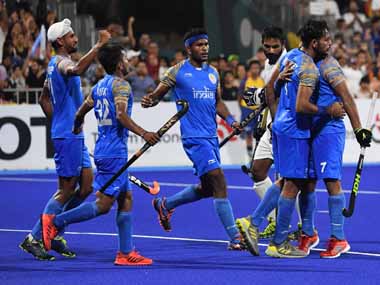On a sun-filled afternoon, 28 June, in Breda, Netherlands, Harendra Singh leaned against the fence of Pitch No 2 generally chatting about the Indian team and the upcoming World Cup. The conversation revolved around player strengths and how playing at home affects a team. At that moment, Argentina had just equalised against Pakistan. By the time our conversation ended, Pakistan had beaten Argentina 4-1; by any standards a big victory and a stunning upset. Except that Harendra refused to call it an upset. [caption id=“attachment_5620341” align=“alignleft” width=“380”] India players celebrate a goal against Pakistan during the bronze medal match at the 2018 Asian Games. AFP[/caption] “It was coming,” he said. “Teams are by and large dependent on players utilising unused channels in key games. I have seen Pakistan and when they are in the mood, or for that matter any team in the top six or eight, they can create a stunning upset. You need the players, their intelligence to be able to figure out that moment in the match that can turn things around. “Otherwise, we all rotate and look for openings. Beyond that coach talk and drawing board, players need to feel and seize the moment. In a big tournament, that’s what a team needs and should do,” he added. Mubashir Ali, Ajaz Ahmed and Muhammad Aleem Khan did that exactly, cutting and dissecting the Olympic champions’ defence to create a memorable win. In Bhubaneswar in their first practice game against Argentina, India played at half pace, once in a while pushing themselves against an opponent more jet-lagged than match-ready. But in moments in each of the quarters, you could see movements that brought a new meaning to fluidity and the swift filling in off space between the forwards and midfield and that crucial area between midfield and defence. Space is utilised by both teams, but the one to create makes it pivotal and decisive in a tournament like the World Cup. One cannot look at the 5-0 scoreline against Argentina in a training game seriously but it gives you a glimpse of what can be achieved. “In essence, I have a team that can do that,” explained Harendra in Bhubaneswar. “There are times when they can switch effortlessly from a seemingly defensive position to complete attacking mode. The mix is crucial and we believe we have that mix of experience and youth.” Maybe, it’s time to move on from that one dark day in Jakarta and look at what can be achieved here at The Kalinga. There are detractors. But then there are the hopeful sprinkled in with the optimists that India can ride on the energy and strength of buzzing and roaring 15,000 rabid fans. The answers lie in the coming together of the three components of a team — forwards, midfield and defence. Akashdeep Singh, who will play his 175th international against South Africa, leads this bunch of skillful forwards and it is his own position that will be most critical. There has been a change in attitude and sense of positioning since the failure at the Commonwealth Games. Akashdeep darts into empty spaces to give the opportunity to others to create their own before flicking the ball back into scoring positions. More and more, he is being used as the link between the midfield and the poachers. Running wide, or cutting in, Akashdeep has the ball skills to hold and release at pace. In short, when he has the ball, situations and opportunities are created. Slightly in the same mode is Lalit Upadhyay, a mix of a midfielder and a forward, but with an eye for goals. Lalit, with 89 matches under his belt and the experience of the last World Cup, understands the mix in the striking circle and usually when alone slips through to the head of the pack and right in front of goal. Mandeep Singh and Dilpreet Singh are the pure strikers and a lot is expected of Mandeep, who has already played 125 matches and was a member of the 2014 World Cup side, much before winning the gold in the 2016 Junior World Cup. Of late, the team has worked on his positioning in the striking circle and he has come a long way. Mandeep would be looking to more moments like the hat-trick against Japan in the 2017 Azlan Shah where he brought back the Indian side from the brink of defeat to a memorable victory. Dilpreet feeds off through passes; unless, there is a strike from the top of the circle. Along with Simranjeet, he is the youngest in terms of match experience (24 games), he has a lovely understanding and that was brought to the fore in the Champions Trophy against Pakistan when Simranjeet, with the ball in the middle of the pitch, did a turn and slipped the ball onto the left flank as Dilpreet beat a defender on pace, picked the ball and slid it past the Pakistan goalkeeper. As Harendra pointed out in his conversation, it was a turning point, a moment was seized. In all, the forwards have played 448 matches and scored a combined 156 goals, good enough for a potent combination to emerge. At the core of the team as Harendra and a host of other coaches call the engine room, India’s hopes are collectively held by captain Manpreet Singh, Neelakanta Sharma, Hardik Singh, Sumit and Chinglensana Singh. It’s also the mix of youth and experience where you have Manpreet with 238 matches and Hardik with just six and playing in his first World Cup. The touches at the Asian Champions Trophy showed maturity beyond his 19 years and hopefully feeding off the fans at The Kalinga, Hardik could emerge as the next big thing in Indian hockey. For many a big stage is all they need and what can be bigger than a World Cup in your own backyard? Neelakanta, as Harendra explained, came into the team for his attacking prowess but more so for his defensive abilities. Neelakanta has played 25 matches with a style similar to that of Chinglensana where attack and fall back have the same pace. Sumit, who will play his 50th international on the opening day of the World Cup, will also be key on the right flank, overlapping and cutting off the opponents attack in India’s half. With his pace, counters could be potent; though there is a tendency of Sumit going flat in certain portions of the match. It’s the captain Manpreet who will hold this midfield together. Inspirational and aggressive by nature, Manpreet does at times give one the feeling of playing defensively and falling far too back but he has the vision of creating channels through the middle of the pitch, dragging the ball and scoring on his own or at least creating those penalty corners. However, a lot also depends on his ball holding skills so pivotal in matches against top opponents. “Defensive duties are a must,” said Harendra, while explaining the difference between being ultra-defensive and manning your area when under the threat of a counter-attack. “Of course, there are times when you have to soak pressure. You need that moment for a counter of your own and you bring in the opponent to create that moment for a strike or a PC. Except for keeping a forward upfront, all the players can fall back in seconds. But we have a tight unit at the back and I am confident that with players like Lakra, Kothajit and Surender, errors will be less.” It’s in the defence where experience is rich — a total of 675 matches between Harmanpreet Singh, Varun Kumar, Surender Kumar, Amit Rohidas, Kothajit Singh and Birendra Lakra. But it’s when Lakra cleared the fitness test Harendra would have heaved a sigh of relief when. Amongst them all, like in the Breda Champions Trophy, he was immaculate, focused and flawless in his tackles. There are times when Lakra gives you the feeling of threading a needle on the run when he picks the ball of a forwards stick. In the same mould is Surender Kumar who also does get adventurous when advancing on the right flank and suddenly you would find him on the touch line of the opponents striking circle. Harmanpreet’s natural skills make him a delight to watch when prancing out of the striking circle and sending in those long hits. Kothajit, with 186 caps, is the one who looks out for stray balls inside the Indian striking circle. But his experience will help steady the ship when under pressure. Varun and Amit do get jittery in moments but yet again it’s the rolling substitution that also plays a pivotal role. Penalty corners form the bulwark of any team which is still a work in progress. In the 218 matches combined that Harmanpreet, Varun and Amit have played they have scored a total of 71 goals; there but not quite there. Yet it is Harmanpreet who would lead this brigade. His play is full of unexpected angles and at times he seems to be playing three to four different roles — defender, attacker, the high-ball visionary and the flicker. Right behind him, roaring away, would be the talismanic goalkeeper PR Sreejesh. At 204 caps, the second most experienced player in the team, his role is usually taken for granted; that’s how good he can be in moments of stress. Check the figures and the tight ones that India win, Sreejesh usually pulls off eight saves out of a possible 10 shots on goal. Consistency may have come down a notch or two but he remains ‘the last man standing’ for India in encounters where defending in numbers seems to be the only trick in the book. India love substituting their goalkeeper at the break. But a wise man once said, ‘Your best is always your best.’ The word brittle is used a lot for India. But for a team that has the combined experience of 1,865 matches between them, solidarity between the three key components, looking out for, as Harendra stressed, ‘key moments’, it will be good to change the narrative for those 15,000 fans that troop in. Maybe, we will hear them say ‘I saw them win’ from the usual ‘I was there.’
For the Indian team, maybe it’s time to move on from that one dark day at the Asian Games and look at what can be achieved here at The Kalinga.
Advertisement
End of Article


)

)
)
)
)
)
)
)
)



